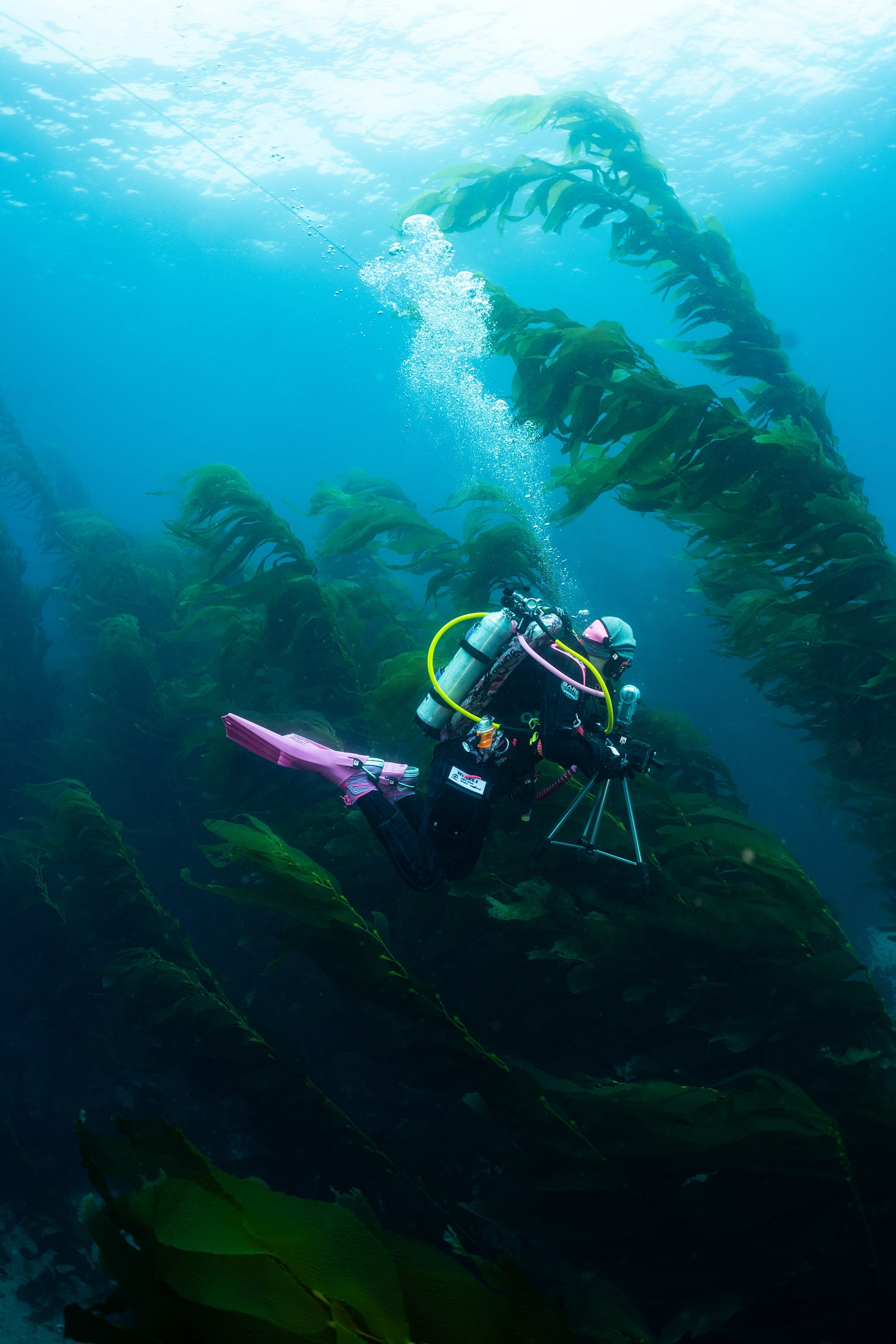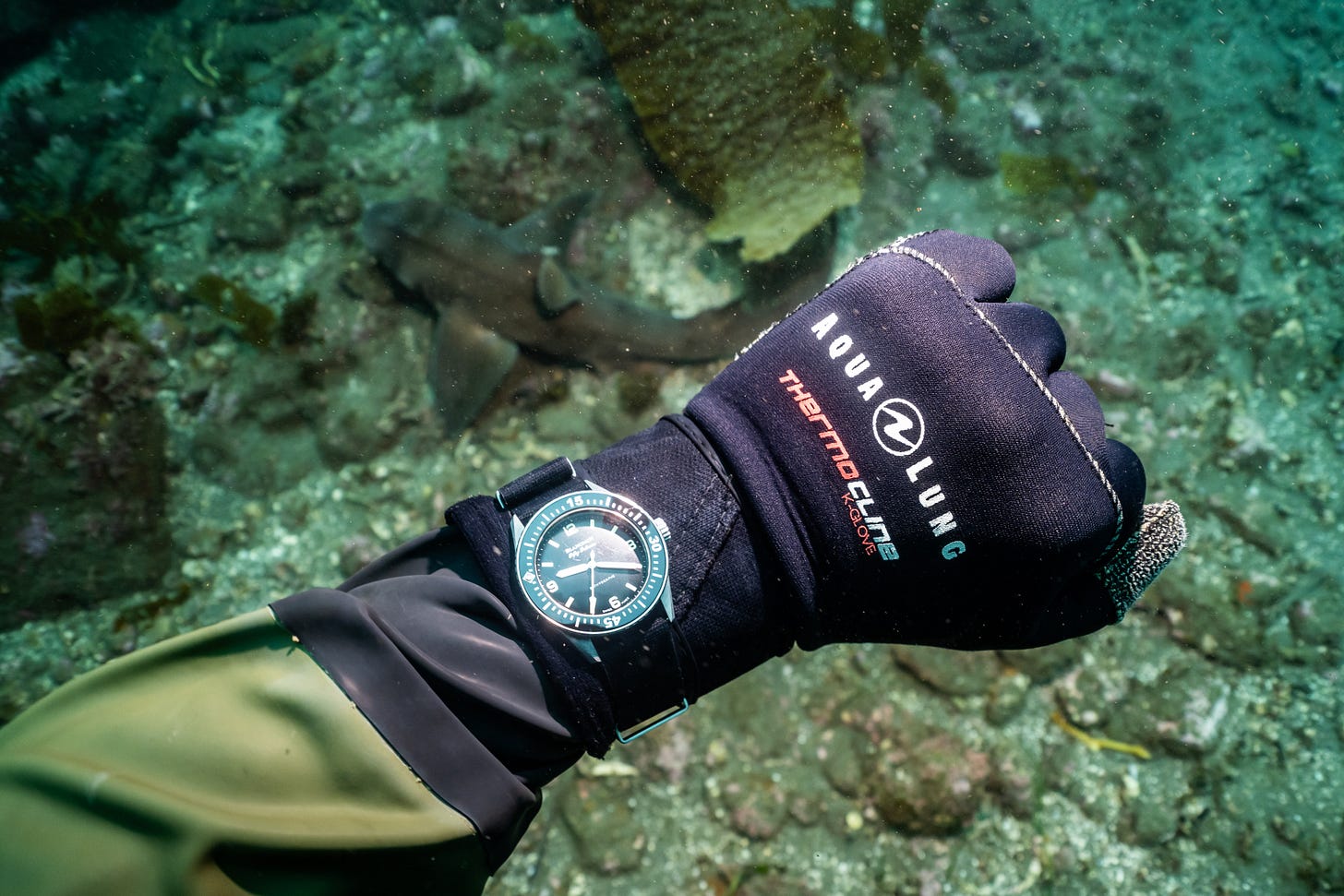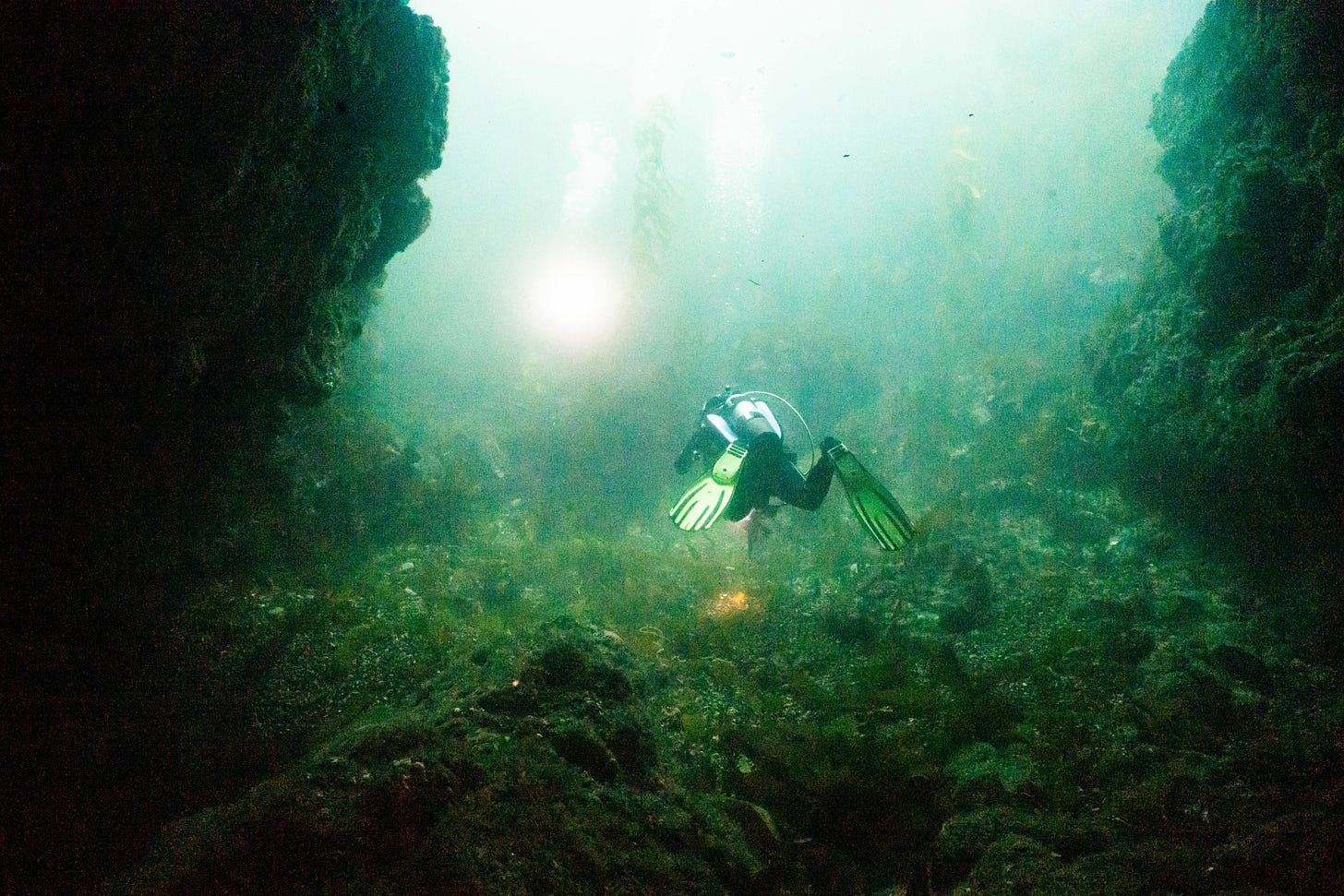The “Potato Patch” is a notorious stretch of water between Santa Barbara Island and Santa Rosa Island. It is so named because a deep water canyon rises steeply there causing turbulent currents and big swells. During particularly rough weather, the waves get churned into a lumpy froth of whitecaps that look like mashed potatoes. To attempt it on a calm day is a challenge, but Captain Troy announced one night that the Peace Boat would be setting off before dawn to run the Potato Patch before the forecasted high winds arrive later in the day. Our goal was to hit a couple of dive sites off of Santa Rosa before returning the way we came, motoring “downhill” with the waves at our stern, to get back to safe anchorage at Santa Barbara. I went to my bunk with some trepidation, popping a motion sickness tablet to keep a steady drip of meclazine in my bloodstream for what lay ahead.
Back in late April, I had joined a team of scientists from Oceana on an expedition to California’s Channel Islands. We spent five days living on the Peace Boat, a 62-foot, 50-year old, wooden dive charter out of Ventura. Despite, or perhaps because of, the close quarters, hard work, and spartan conditions, our team developed a real bond forged on a great adventure. So when the expedition leader invited me back for round 2 in September, I didn’t hesitate to accept.
Expedition life is addictive, especially diving expeditions living on a boat. Something about the distilled existence of living out of a duffel bag, hard work, focused activity, sun, salt, and breathing compressed air has a way of stripping away life’s worries, both small and those we perceive as large. Being offshore, even with Starlink internet, removes you from the noise and static of the world. My days became quite simple: prep dive and camera gear, dive, download photos, eat, rest, dive two more times, then to bed early in my fetid, coffin-sized sleeping berth that I shared with all my gear. In between, it was chatter in the galley or on the dive deck, jackets on against the wind, coffee in hand. Everyone had their roles: Adrian filtering the DNA out of the seawater he collected in a bag while diving or from a Niskin bottle dropped overboard in 300 feet of water, Jamie processing and uploading countless gigabytes of images and video from a number of topside and underwater cameras, Danny and I sorting our camera gear and editing photos, or the boat crew filling tanks, hauling and setting anchor.
And then there was Mikey. To call him a mere cook is to do him an injustice. From 5:30am with the coffee until the last dessert, he worked tirelessly in the tiny, pitching galley. It was a steady stream of nourishment: omelets, biscuits and gravy, fruit smoothies waiting for us after a dive, basmati rice with kebabs, pizza, and the freshest fish that some of the crew speared every day. I found I was insatiably hungry, so that no matter what or when he put out, I would greedily fill my plate. Something about a lot of diving that makes me hungrier than almost anything else. I think it’s an accumulation of constant activity, hefting heavy gear, swimming against current, breathing compressed air, and the body keeping warm in cold water that turns up the metabolism to full boil.
The week started ominously. Late word from our expedition leader pinged as soon as I turned on my phone upon landing in Los Angeles. A COVID-19 test he did that morning turned up positive and he wouldn’t be joining us. Oh, and the weather had turned for the worst, with gale force winds and big seas forecast, so we wouldn’t be attempting the planned overnight crossing to the islands. Facing 15-foot waves in the dark was simply too risky. If we didn’t get out the next morning, we’d likely have to scrub the whole expedition. The week’s marine forecast looked sketchy at best, and would only get worse.
As it happens, we did get out of Ventura harbor the next day and the crossing was, as they say, “sporty.” I opted to ride it out in my berth, and could feel the hull beneath me bashing on successive swells. If we survived this, we’d then spend the next days sailing from the shelter of one island to another, anchoring on their leeward sides, diving in protected coves. The captains, Troy and PJ, were master navigators, and every morning was a chess match, moving the boat based on the weather, battening down for crossings between islands, then fitting in dives before conditions worsened before finding a quiet place to drop anchor for the night. In between, they would motor offshore as far as was prudent, to find a spot for Adrian to drop his collection bottle overboard for deepwater sampling.
Despite the topside conditions, underwater, the diving was objectively better than it was in April. The water was considerably warmer and the visibility better, with less nutrients drifting around to obscure our view, making for a pleasing blue backdrop for photos, as opposed to the green we had a few months ago. There were only two of us wearing drysuits this time—safety diver Mineli, and me—and despite the warmer conditions I was still glad for it. There’s something smug about stepping out of a drysuit and fleece “onesie” after a dive, warm and comfy in my shorts and T-shirt, while everyone else was pouring hot water down the fronts of their sodden wetsuits.
I logged ten dives over four days—two each on the “travel” days and three on the other two days. All of them were in kelp forests, the signature ecosystem of the Channel Islands. Kelp can be a little spooky and intimidating to dive in for the uninitiated. Not only is it dark near the bottom, but the undulating stalks of these massive plants can truss up a diver like a Thanksgiving turkey if he’s not careful. Once you find yourself snagged, whether on a fin or a regulator valve, it’s important not to panic, but to slowly back up and not spin around, lest you get further entangled. Once you get the hang of it, kelp diving is so rewarding. On one dive off of Santa Cruz Island called Fence-Line, we descended in crystal clear, blue water, drifting down above 60-foot tall kelp. It felt like skydiving over the canopy of a jungle. For perspective, I thought of the huge elm trees that grow around my house in Minneapolis and imagined approaching them from above. This was by far the best dive site of the week, and as we touched down on the bottom, two bat rays swooped past, swimming off into the distant gloom. Another diver gestured to me, pointing at the sea floor, and as I hovered there, some kelp leaves parted revealing a huge decorator crab.
We had multiple interactions with harbor seals, someone saw a tope shark swimming out of the kelp, and Danny found an angel shark camouflaged in the sand on a dive. The only shark I saw was also a special one—a shy horn shark lay on the bottom, waiting until I got close enough for a photo before it turned and swam off. I saw iridescent Garibaldi fish on every dive. Perhaps they felt a kinship with me and my equally orange neoprene hood. On the surface, we were often accompanied by pods of leaping dolphins, playful sea lions, and even a giant mola mola. I’ve said it before: if you’re willing to brave the conditions, the Pacific Ocean delivers, and you never know what you’re going to get.
Of course, the other side of expeditions is the funding, and Oceana again partnered with Swiss watch company, Blancpain, for underwriting. So in addition to collecting data on swimming transects, and getting photos of critters, it was partly my job as a member of the photography dive team, to get photos of Fifty Fathoms watches on wrists. Blancpain provided a steel Fifty Fathoms, while I brought my own titanium reference, along with my limited edition Hodinkee Bathyscaphe. Being behind the camera most of the time, I ended up strapping all the watches on other divers’ wrists. One “grail” shot we wanted to get was some charismatic animal in the background with a watch on someone’s wrist in the foreground. Underwater watch photography is challenging enough, but to pull this off would take a perfect confluence of timing, visibility, and positioning. Turns out I came close, and the watch happened to be on my own wrist. After getting a closeup of the horn shark, I pulled the camera back as far as I could to focus, and held out my wrist with my Blancpain on, and fired blindly, hoping to get it all in the scene. It sort of worked.
Needless to say, since I am writing this on my back patio, we survived the Potato Patch. Captain Troy later told us even he was a bit nervous, having never taken the geriatric Peace Boat through there in such rough seas. The boat was bobbing weaving, drifting its stern like a sports car, to and fro as he maneuvered it to stay bow on to the waves. Once through the worst, we could feel the difference in the lee of Santa Rosa. The trip back after the dive that morning felt like surfing down an endless wave and a group gathered on the dive deck just to witness the raw power of the ocean.
After a final day diving below the lighthouse on the north coast of Anacapa, we turned for the mainland. Of course, this last day was the calmest, and presented the most placid conditions, making packing up gear easier. As we entered the marina in Ventura, I felt both relief and a twinge of regret. While a soft bed, a hot shower, and a proper toilet would be welcome, I would miss this team, this boat, and this raw, physical activity. But then, over beers at the hotel that night, there was mention of a third expedition next year. “Count me in,” I blurted out without hesitation, before realized that I was merely a guest on Oceana’s expedition. “We’d love to have you back,” someone said, smiling. I’m counting the days.










As an Ex-Smokejumper for nearly 20 years I've had many adventures parachuting into remote forests throughout the CONUS and Alaska to fight wildland fires. Those days are now long gone. But the memories and stories they hold are still being told and written about. Great to see you and others having adventures and giving us your stories. Keep them coming!
Proper adventure.